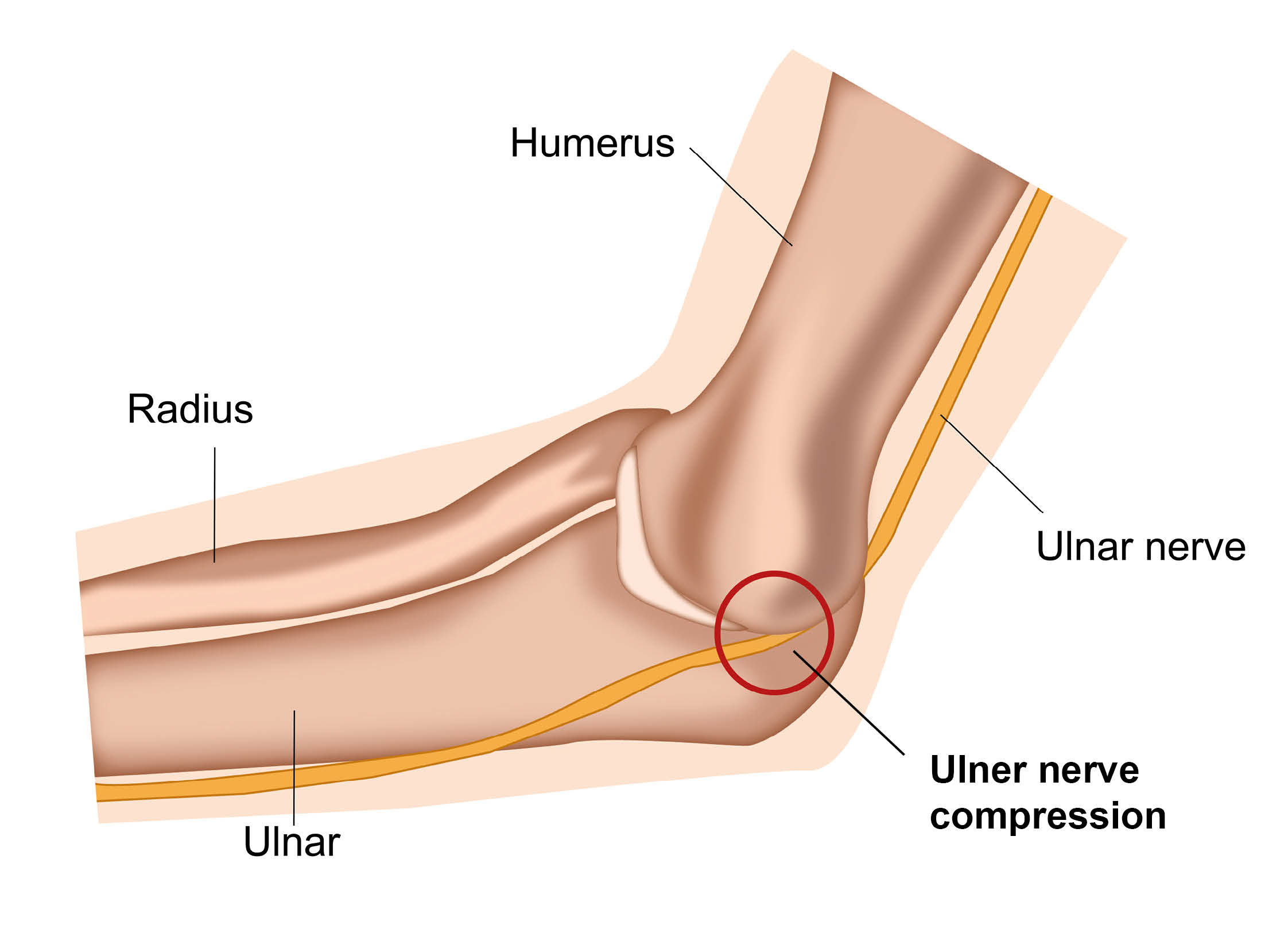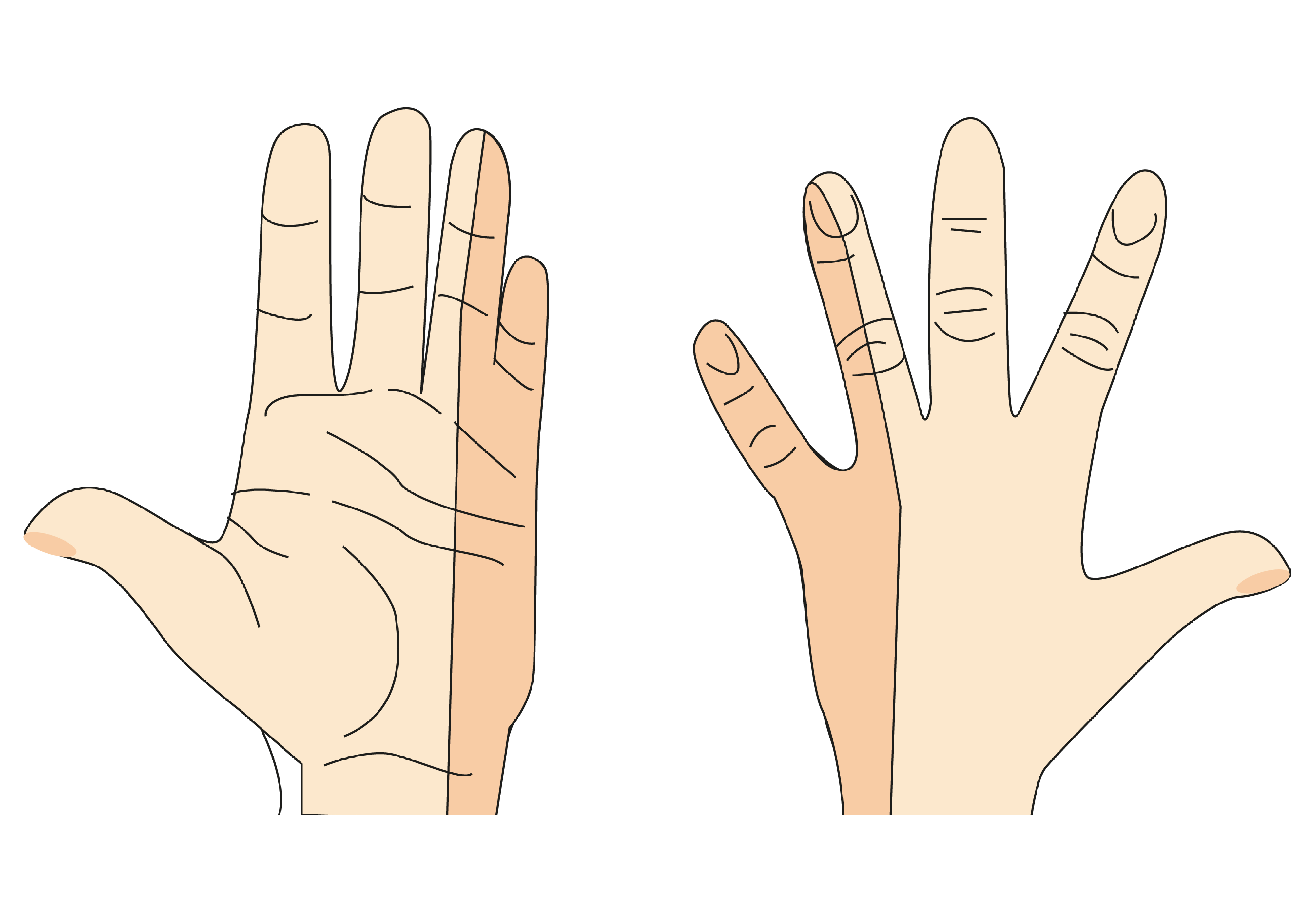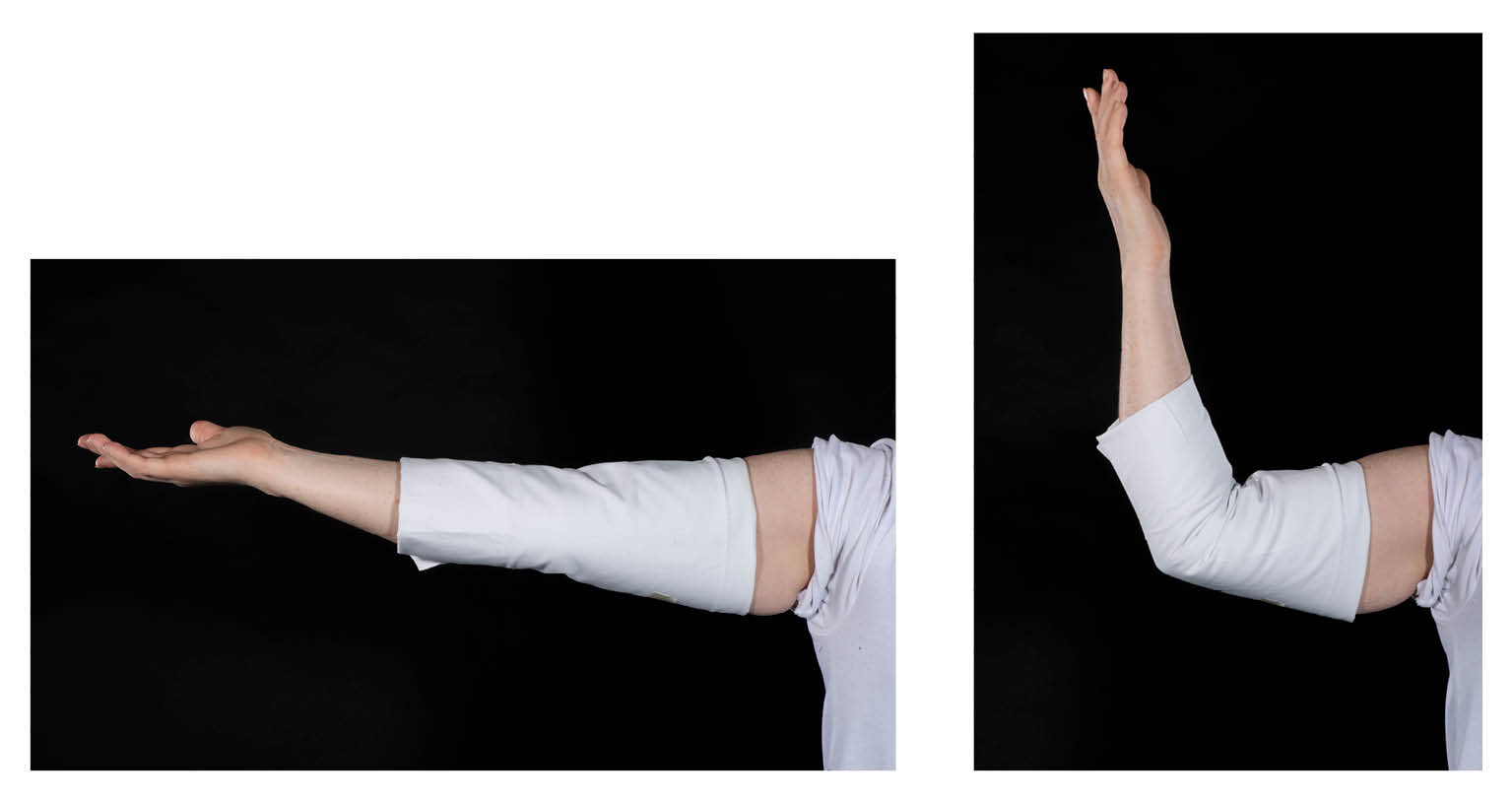Cubital tunnel syndrome
Information for patients from the Orthopaedic Hand Service
You have been diagnosed with cubital tunnel syndrome. This leaflet explains:
what cubital tunnel syndrome is
what causes the condition
what the symptoms are
how it is diagnosed and treated; and
what happens if you decide to have surgery.
We hope this leaflet answers some of the questions you may have. If you have any further questions or concerns, please speak to your therapist.
What is cubital tunnel syndrome? and, why do I have it?

The ulnar nerve is one of three main nerves which runs from your spine to your hand. It provides feeling to your little finger and ring finger, and powers the small muscles of your hand. It is vital for hand function.
Cubital tunnel syndrome happens when your ulnar nerve gets:
compressed (squeezed); or
irritated in the tunnel found on the inside of your elbow (where your ‘funny bone’ is).
Compression or irritation stops the nerve from working correctly.
What are the symptoms?
Early symptoms can include:
pins and needles or numbness, that comes and goes, mainly in your little and ring fingers; and
pain on the inside of your elbow.

You may find most of your symptoms happen overnight or first thing in the morning. As the condition progresses, these symptoms can start to happen more often.
In more severe cases, you may notice muscle wasting in some of the muscles between your fingers. You will see this on the back of your hand between your thumb and index finger.
You may also notice a loss of grip strength, for example you may find it harder to open jars or use door handles.
What causes cubital tunnel syndrome?
There is no obvious cause in most cases of cubital tunnel syndrome. However, there are different factors that can lead to cubital tunnel syndrome.
Repeatedly bending your elbow (this could be due to your job or hobby).
Resting with your elbow bent for long periods of time, for example when sleeping.
Direct trauma (injury) to your elbow.
A previous elbow fracture.
You are at increased risk if you are obese, or have osteoarthritis, diabetes, or hypothyroidism.
How is it diagnosed?
Your doctor or therapist will carry out a physical examination to see if they can reproduce your symptoms. The results of this examination and your symptoms are often enough to diagnose the condition.
They may also carry out nerve conduction studies (NCS). These studies check the signals passing along your ulnar nerve. Your doctor or therapist will place small metal wires called electrodes on your skin. These electrodes release tiny electric signals or impulses to stimulate your nerves. This can help your doctor or therapist see how bad your nerve compression is.
What are my treatment options?
Mild to moderate cubital tunnel syndrome, is often treated with advice and guidance from your therapist or doctor.
The following are some key points to help you self-manage your symptoms.
In the early stages, the main treatment is avoiding or changing any activity which aggravates your symptoms. This may significantly reduce the pressure on your nerve.
This may include a workstation assessment. Changes could include:
wearing a headset when using the telephone
placing your computer keyboard at the edge of your desk; and
using a chair that does not have an arm rest.
Avoid bending your elbow for long periods of time. For example:
when you are on the phone
leaning your head on your hand; or
resting your elbow on a firm surface.
Take regular breaks from repetitive tasks. Rest with your elbow in a comfortable position.
Wearing an elbow splint at night can keep your elbow in a neutral or slightly bent position. This reduces the pressure on your nerve (see below for more information on splints).
Wearing an elbow splint
We may recommend keeping your elbow a little straighter when sleeping. This will reduce the stretch on your ulnar nerve, which can happen when your elbow and arm are curled up at night.

You can make your own splint, or buy a neoprene type elbow splint from your local chemist or online.
To make your own splint
Fold a hand towel in half.
Wrap it around your elbow.
Secure it in place with tape. Make sure that it is not too tight or cutting off circulation.
This will be comfortable enough, and will stop your elbow from bending too much.
Wear the splint every night for 6 to 8 weeks. It may take several weeks before you notice a difference in your symptoms. If your symptoms get better but do not stop completely, you can wear the splint at night for up to 12 weeks.
Ulnar nerve gliding exercises
Ulnar nerve gliding exercises can also be helpful, to move the ulnar nerve through the cubital tunnel. When you do these exercises, you may feel a pulling in your little finger. However, these exercise should not be painful or make your symptoms worse.
If your symptoms do get worse, cut down how many times you do each exercise or stop them altogether.
-
.jpg) 1. Begin with your arm out to the side, with your palm facing down.
1. Begin with your arm out to the side, with your palm facing down. -
.jpg) 2. Bend your wrist backwards, so your fingers point to the ceiling. Hold for 10 seconds.
2. Bend your wrist backwards, so your fingers point to the ceiling. Hold for 10 seconds. -
.jpg) 3. Bend your elbow, so your hand points towards your head. Hold for 10 seconds.
3. Bend your elbow, so your hand points towards your head. Hold for 10 seconds. -
-1721390795.jpg) 4. Straighten your elbow and wrist back to the starting position.
4. Straighten your elbow and wrist back to the starting position.
Repeat 3 times.
When the stretch starts to feel easy and the pins and needles are getting better, increase to doing this exercise 5 times. This may be after a week or two.
Repeat this exercise up to 3 times every day. Increase to a maximum of 10 repetitions, as your symptoms get better.
Why has my doctor or therapist recommended surgery?
In severe cases or when the non-surgical treatments listed above have not worked, you may need an operation to relieve the pressure on your nerve. This surgery is called decompression.
The benefits of decompression surgery depend on how bad your compression is.
Your numbness will often improve after surgery, but this can be a very slow recovery.
In the most severe cases, the feeling in your fingers may not completely recover.
Surgery generally prevents muscle weakness from getting worse. However, improvements in muscle strength are often slow and incomplete.
What happens during surgery?
Surgery will involve a cut around the inside of your elbow, about 10cm long. The surgeon will then release the tight tissues squeezing your nerve.
Will I have an anaesthetic?
Yes. Surgery is usually performed either with:
local anaesthetic, which numbs the area around your elbow; or
a regional anaesthetic, which numbs the whole arm.
You are awake during the surgery. Your doctor will discuss which anaesthetic you will have during your clinic appointment.
What happens if I choose not to have the operation?
If you choose not to have the operation:
your hand may become weaker
it may be difficult to grip items tight with your thumb; and
you may develop complete numbness in your little and ring fingers.
What are the risks with surgery?
Serious complications are uncommon. However, a small number of patients can have complications, some of which resolve with time. These include:
Delayed wound healing or infection. A small number of patients will develop an infection and may need antibiotics. Very rarely they may need another small operation to clean out their wound, called a washout procedure. This is more common in patients with diabetes.
The scar may be tender for many months. If it does not get better with time and regular scar massage, a course of therapy may help.
Aching and pain around the elbow; this usually gets better with time.
Reduced feeling in little and ring fingers can continue even after surgery.
Nerve damage can happen during your surgery. This may result in either a painful spot in your scar (neuroma), or some numbness around the scar or into your thumb. This often settles within a couple of months.
Complex Regional Pain Syndrome (CRPS) is a very rare condition. It can cause severe pain, swelling, and stiffness in your hand. CRPS can take several months to improve or may even continue. The onset of CRPS can often be gradual and you may not notice it for 4 to 6 weeks.
After 4 to 6 weeks, please contact your surgeon or visit your GP, if:
you have ongoing persistent pain; and / or
swelling throughout your whole hand.
Please remember that most patients have an uncomplicated routine operation. They are happy with their recovery and outcomes. If you have any concerns about these risks, please speak to your surgeon or therapist before your surgery.
What happens before my operation?
The Pre-assessment Clinic will contact you before the day of your operation. At this appointment a nurse will discuss your operation with you. You may need to have some routine tests before your operation, such as a blood test. Please feel free to ask questions and raise any concerns that you may have about your operation.
During this appointment, the nurse will ask you questions about your general health. It would be helpful if you bring your usual medicines with you. The nurse will need to know their names and the strengths. This includes non-prescription medicines, such as herbal and complementary medicines.
If you need to stop eating or drinking before your surgery, the nurse will discuss this with you
Why do I need to sign a consent form?
All patients must give permission before they receive any type of medical treatment, test, or examination. Consent is usually given when you sign the consent form before your treatment, but we may ask you to give it verbally.
You must give your consent voluntarily.
The hospital must give you all the information you need to make a decision about your treatment. This is so you can give us informed consent. If you have not been given this information, or you have but you still have questions, please speak to a member of staff.
You must be capable of giving consent. This means that you understand the information given to you and can make an informed decision.
When we ask you to give consent, please use this time to ask any questions you may still have. For more information, please go to the NHS Consent for Treatment web page. Remember, you can withdraw your consent for treatment at any time.
Stopping smoking
Compared to non-smokers, smokers are more likely to have complications in tissue healing and infections after injuries or surgery. For free friendly support and medication to help you stop smoking, contact:
How long will I be in hospital?
The operation is carried out as a day case, so you will go home on the same day as your operation. Plan to be in the hospital for up to 6 hours.
You cannot drive after your surgery. Please make sure you arrange for someone to take you home after your operation. Tell your doctor or therapist if this is a problem.
How will I feel after my operation?
It is normal to feel a little discomfort after your surgery. It is not common to be in large amounts of pain. If you feel pain and you can take this type of medication, take simple painkillers (such as paracetamol).
What should I do if I am concerned about my hand?
You should contact your GP or local Urgent Treatment Centre if you have any of the following.
Loss of feeling in your hand or fingers.
Discoloration of your hand or fingers.
Your fingers become hot or cold all the time.
Increased swelling or tenderness.
Increase in pain.
You are worried about an infection.
When can I drive and go back to work?
Arrange for someone to drive you home after your surgery. Do not drive again until your arm feels comfortable when using it for general daily activities. This is often around 1 to 2 weeks after your surgery.
When you can return to work depends on the work you do.
If your job involves light duties you can return 1 to 2 weeks after your surgery.
If your job involves more demanding work, you may not be able to return for around 3 to 6 weeks.
If you are unsure, please speak to your GP or therapist.
When can I return to my normal activities?
Return to normal everyday activities as your pain allows. This is often 1 to 2 weeks after your surgery.
Do not do any excessive weight bearing activities for the first 4 weeks following your surgery. These activities include pushing up from a chair or heavy gripping.
Will I need a follow-up appointment?
You may not need a follow-up appointment. If your consultant would like you to see you again, they will organise this for you. Otherwise, you will be placed on a Patient Initiated Follow-Up (PIFU). You will be given details on how to organise a review yourself, if you have any concerns once you return home.
Hand therapy after surgery is not usually needed.
When will my dressing and stitches be removed?
You can remove your bulky arm dressing 48 to 72 hours after your surgery.
Leave the small dressing over your wound for a further 7 days. You must keep this small dressing clean and dry.
If you have dissolvable stitches, these will start to fall out 10 to 14 days after your surgery. The stitch knots at either end of your scar may take a little longer to dissolve.
If you had non-dissolvable stitches, your GP, practice nurse, or consultant will remove these. You will be told which type of stitch you had before you leave hospital.
How do I care for my scar?
The length of the scar will vary between patients. The number of stitches also varies, but the surgeons aim to make the scar look as good as possible.
Your scar may become sensitive to touch while it heals. It is very important to start to massage your scar around 2 weeks after surgery. You do this with a small amount of water-based hand cream for up to 8 weeks after surgery. This will help to soften the scar tissue and reduce its sensitivity.
For more information on scar massage, please ask a member of staff for a copy of the Trust’s Scar Massage leaflet.
What if I have any questions or concerns?
If you have a lot of pain, swelling, or tenderness around your wound you may have an infection. If this happens, please go to your GP or Urgent Treatment Centre to have your wound checked.
If you have any other questions or concerns, please speak to your consultant or therapist.
Further information
What do you think of this leaflet?
We welcome feedback, whether positive or negative, as it helps us to improve our care and services.
If you would like to give us feedback about this leaflet, please fill in our short online survey. Either scan the QR code below, or use the web link. We do not record your personal information, unless you provide contact details and would like to talk to us some more.
If you would rather talk to someone instead of filling in a survey, please call the Patient Voice Team.
Patient Voice Team
Telephone: 01227 868605
Email
Ask 3 Questions
There may be choices to make about your healthcare. Before making any decisions, make sure you get the answers to these three questions:
What are my choices?
What is good and bad about each choice?
How do I get support to help me make a decision that is right for me?
Your healthcare team needs you to tell them what is important to you. It’s all about shared decision making.